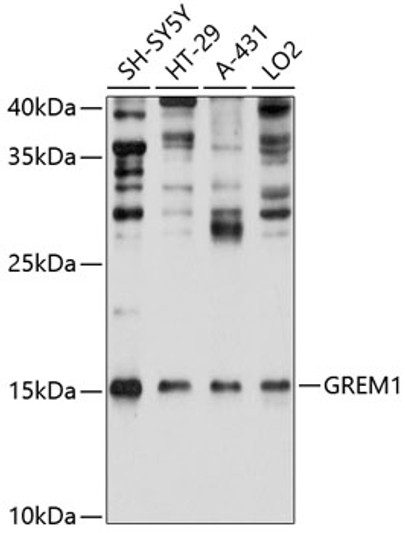| Tissue Specificity | Highly expressed in small intestine, fetal brain and colon. Expression is restricted to intestinal subepithelial myofibroblasts (ISEMFs) at the crypt base. In subjects with HMPS1, by contrast, GREM1 is expressed, not only in basal ISEMFs, but also at very high levels in epithelial cells (predominantly colonocytes), with expression extending most of the way up the sides of the crypt. Weakly expressed in brain, ovary, prostate, pancreas and skeletal muscle. In brain found in the region localized around the internal capsule in the large subcortical nuclei, including caudate, putamen, substantia nigra, thalamus and subthalamus. Predominantly expressed in normal cells including neurons, astrocytes and fibroblasts. |
| Function | Cytokine that may play an important role during carcinogenesis and metanephric kidney organogenesis, as a BMP antagonist required for early limb outgrowth and patterning in maintaining the FGF4-SHH feedback loop. Down-regulates the BMP4 signaling in a dose-dependent manner. Antagonist of BMP2.inhibits BMP2-mediated differentiation of osteoblasts (in vitro). Acts as inhibitor of monocyte chemotaxis. Can inhibit the growth or viability of normal cells but not transformed cells when is overexpressed. |
| Protein Name | Gremlin-1Cell Proliferation-Inducing Gene 2 ProteinCysteine Knot Superfamily 1 - Bmp Antagonist 1Dan Domain Family Member 2Down-Regulated In Mos-Transformed Cells ProteinIncreased In High Glucose Protein 2Ihg-2 |
| Database Links | Reactome: R-HSA-9830674 |
| Cellular Localisation | Secreted |
| Alternative Antibody Names | Anti-Gremlin-1 antibodyAnti-Cell Proliferation-Inducing Gene 2 Protein antibodyAnti-Cysteine Knot Superfamily 1 - Bmp Antagonist 1 antibodyAnti-Dan Domain Family Member 2 antibodyAnti-Down-Regulated In Mos-Transformed Cells Protein antibodyAnti-Increased In High Glucose Protein 2 antibodyAnti-Ihg-2 antibodyAnti-GREM1 antibodyAnti-CKTSF1B1 antibodyAnti-DAND2 antibodyAnti-DRM antibodyAnti-PIG2 antibody |
Information sourced from Uniprot.org






